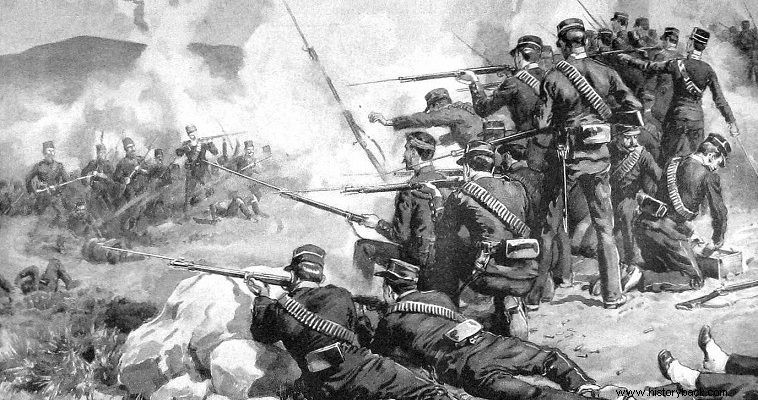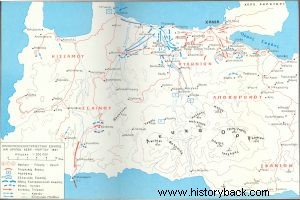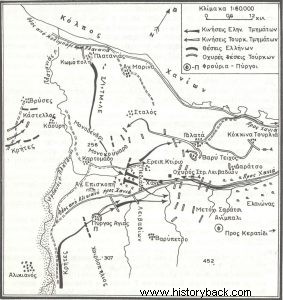
One of the darkest periods of Turkish rule in Crete was the five years 1890-1897. The Greeks had begun to manifest, in practice, intense reactions against the Turks. On January 23, 1897, 500 Turks attacked the Greeks at Akrotiri and besieged Halepa. In the meantime, the Greek Consul of Chania, N. Gennadis, after the refusal of the Admirals to disembark the vessels, telegraphed the Greek Government for the urgent dispatch of "occupation ships and army" to protect the Christians.
On January 25, the Cretans managed to maintain their positions around Chania, lifted the siege of Aleppo and occupied the entire surrounding plain. They established a provisional government for this part and by their resolution they declared the union of Crete with Free Greece. The events in Crete had a great impact on Greece. Public opinion and the opposition demanded that the government take measures. On January 25, the consul general of Chania, N. Gennadis, telegraphed that "the fire and massacre will exterminate all Christians". All this forced the government of Greece to take new measures.
The mission of the Greek expeditionary force to Crete and the occupation of the island by the European forces
The mission of the Greek force was entrusted to the aide-de-camp of King George I, Colonel Timoleon Vassos, who, based on the orders he received, had to occupy Crete "in the name of the King of the Greeks" and restore order there. Thus a Greek body was formed and set sail for Crete.
In the meantime, Colonel Vassos, following information he received in Milos, that possibly the English Admiral Harris would prevent the disembarkation of the corps in Chania, and after arming and taking with him 150 Cretan refugees, who had taken refuge there, took care of and met near Antimilos with the leader of the Torpedo Squadron, Prince George. There he was informed in more detail about the situation, modified his initial plan of action and headed towards the western side of the Gulf of Chania, in the province of Kissamos.
At 11:00 p.m. on February 2, the three ships approached with their lights off at Kolymbari Bay, near the Gonia Monastery, and the disembarkation of the men and war material, which was transferred to the monastery's warehouses, began immediately. The Headquarters of the Corps was also temporarily established in it. On the following February 3rd, Admiral Reinek arrived in Kolymbari with the flagship "Hydra" (which was followed by "Alfeios") with the Consul General of Chania N. Gennadis. After a meeting, it was decided to implement the plan that Colonel Vassos had drawn up. According to this, the Greek forces should have occupied the heights of Halepa early in the morning of February 4.
Then, after a eulogy sung in the Monastery, in the presence of thousands of Cretans and the reading of the "Proclamation to the people of Crete" by Chief Vassos, the movement of the Corps to Chania, from the coastal road, began at 3:00 p.m. After a march of 3 hours the force reached the bridge of the river Platanias (Yardanou). There Colonel Vassos was informed that the city of Chania had been placed under the protection of the Great Powers since February 3rd. Following instructions from their governments, any action against the city was prohibited, after which he installed his force in the village of Platanias and telegraphed it to the government, asking for instructions.
In the meantime, Turkey protested to the Forces about the Greek mission of an expeditionary force, because after the imposition of international occupation and the previous agreement, it could not send new military forces to the island. At the same time, however, he promoted the Headquarters of the Army of Thessaly, under Etem Pasha, near the Greek-Turkish border. Finally, as chief of staff he placed Seifullah Bey, a former military attaché of the Turkish embassy in Athens, who, because of his position, was knowledgeable about the country's interior. On 5 February the international occupation was extended to other coastal towns and fortresses on the island. The Greek Government, for its part, instructed Colonel Vassos to avoid coming into conflict with the forces of the European ships that the Admirals had landed.
On February 4, 600 volunteers arrived from Athens to the camp of Platanias, led by the Cretan chieftain Hatzi-Mihalis Giannari. Colonel Vassos assigned him to go to the villages of Alikianos and Lakkos to monitor the Turkish positions of the tower of Agia and the fortress of Animbali. The 120 of the above volunteers were students, under Artillery Captain Emmanuel Zimvrakakis, whom Vassos organized into a separate company, after recalling their leader to active military service. He did the same for Artillery Major Manousogiannakis Emmanuel. He assigned to him the command of the artillery, as well as the command of the corps of volunteers (under the commander-in-chief Daskalogiannis) and a similar detachment of regular army which would serve as a supplementary force of the Artillery. Other corps of volunteers were placed under the command of various officers of the Corps.
After reconnaissance of the enemy positions and forces, it was estimated that the camp in the village of Platanias was not safe, neither from the sea, due to the strong presence of ships of foreign uniforms in front of the camp, nor from the land, where the Turkish troops occupied a series of strong positions , as follows :
- To the east, in front of the camp, the fortress of Chania with a force of 8,000 men and 6 artillery pieces.
-Southeast, on the heights above Souda, the fortress of Malaxa and west of it the Keratidi tower. Then the Anibali fort and the Metohi Sarachi fortified hill in front of it. The fort barracks of Livadia and the Agia Episkopi (Agia) tower. This whole line of national posts extended to the river near the village of Alikianos, and had 3,000 men of the regular army and 14 guns.
-Southwest, from the camp the fortress of Voukolia (with an infantry battalion) in the province of Kissamos and south of it (22 kilometers) in the province of Selinos the fortress of Stavros with a company and 2 guns. Finally the city of Candanus with two cannons, whose inhabitants and regular army amounted to 1,500 warriors. In order to secure the camp in Platanias as well as the materials that were stored in the Gonia Monastery, as well as to achieve uninterrupted communication with the interior of the island, Colonel Vassos decided, following instructions from the local chieftains, to neutralize the left southwestern end of the enemy line, occupying the fortress of Boukolia.
The battles of Voukolia and Livadia
For the operation against the Voukolians, a mixed detachment was formed on February 5, in Platanias, under the orders of Infantry Major Konstantinidis Ioannis, which consisted of :
The I/7 Infantry Battalion
Artillery ulama with two guns
Engineer Platoon
Department of surgery
The Student Company (under Captain Zimvrakakis Emman.)
Various bodies of Cretan and foreign volunteers (3,000 men)
The detachment moved on the same day, at 1500 and with a short march arrived at the village of Gavalomuri at 1900, where, after overnight reconnaissance, it occupied positions around the fortress of Voukolia. To the north-east and north-west of this parts of the Detachment were established, while a company was advanced west as an ambush. The rest of the siege of the fortress was entrusted to the Cretan corps.
The following day, 6 February, after repeated refusals by Turkish Guardsman Fuat, commander of the 1/34th Battalion holding the fort to surrender, an artillery assault began at 0800. However, due to the limited results, a new order of artillery was required, in a position closer to the fortress, which had been identified by the reconnaissance of the night, when the shots were devastating for the Turks. The situation of the latter became even more difficult, when in the afternoon the Evzones division together with the Cretan corps took over, with the support of artillery, the no. I external work, east of the fortress.
However, despite the increasing losses of the Turks, the battle continued until the evening, which was to the detriment of the besiegers, since sooner or later Turkish reinforcements would arrive for the besieged. Thus, during the night, an order was given to the bodies of Cretans, who were guarding the road that led from the fortress to Chania, to withdraw from there and leave free the escape of the besieged. At the same time, however, they placed ambushes by bodies of Cretans near the Kastellos hill, with orders to block and arrest the Turks who would break through and head towards Chania.
At midnight Major Fuat with the rest of the garrison (about 200 men) left the fortress and from the unguarded side moved towards Chania. On the way, however, he was surrounded at the top of the Kastellos hill by the resident Cretans and rejecting the surrender proposals, he continued to defend himself bravely throughout the day of February 7. The following day (February 8), Fuat was killed and what remained of his men surrendered.
In the meantime, on the morning of February 7, the Cretans realized that the fortress was empty and occupied it. More than 100 Turks were found dead in it. Essentially, the Turkish 1st Battalion of the 34th Infantry Regiment there was disbanded. The Greek losses were:from the Cretan corps 15 dead and 37 wounded and from the regular army 2 wounded. The Turkish supplies and war material were left at the disposal of the Cretan troops, while the fortress was blown up.
The Turkish Military Commander in Chania was informed of the siege of Voukolia on the night of February 6/7 and he hastened to assemble and send to help a body of 1,500 hoplites with 3 cannons and 2,500 irregular Turkish Cretans. Colonel Vassos, who had predicted that the Turks would not respect and violate the neutral zone around Chania, had already ordered his units to be ready. He had also ordered Commander-in-Chief Hatzi-Mihalis Giannaris to monitor the garrisons of Agia, Animbali and Saratsi and to notify him of any suspicious movement by the Turks.
On the morning of February 7, the Greek guards reported that unusual movement of Turks was observed outside of Chania and the barracking of units near the olive grove of Chania. Later on at 1000 and after the Turks had attacked the Cretan corps defending in the fortified positions of Monokoumaro and Monodendri, Colonel Vassos sent to reinforce them, first the Evzonon Company and then the Engineer Battalion (minus the Company), under Major Tzavella Ioannis. After noon, following a report of new Turkish forces pressing the above positions, Colonel Vassos himself, head of the I/1st Battalion, rushed there, after leaving the artillery, an Engineer company and a body of Cretans under the Major Manousogiannakis.
The Turkish provision was as follows :
– In the center, in front of the olive grove of Chania, 4 battalions, with a strength of about 2,000 men. Another Turkish battalion with 4 guns held the fort barracks of Livadia and the adjacent Hani.
- On the northern side, from the right of the regular army formation up to the fortifications of the Red Towers, bodies of disorderly Turkish Cretans were lined up. At various distances in front of them, other bodies of miscreants occupied individual houses, enclosures, or dry stone foundations, while others were spread out in acrobolistic order on the edge of a small adjacent olive grove.
-The southern (left) flank, held by the regular army, was lined up on the fortified heights of Metohi Saratsi, on the strongest fortress of Anibali, (1 infantry battalion) and finally on the tower of Agia. The total strength of the enemy was estimated at six thousand men, with 14 mountain guns. After assessing the battlefield, the Greek units were ordered to advance from Monokoumaros and using the existing ravine there, they descended and deployed on the plain.
Immediately the right wing of the Greek formation, together with the Cretan corps of Oplarhigos Hatzimichalis, occupied the tower of Agia to the south. The garrison as well as the body of Turko-Cretans outside the tower after a short resistance retreated, the tower was captured and set on fire. During this time, the center headed towards the opposite Turkish barracks of Livadia, while the left (I/1st Battalion) successively neutralized the strong points held by the enemy at the foot of the mountains and, after stubborn resistance, pushed the Turkish Cretans out of the small olive grove.
Afterwards, the ends of the Greek formation, after the overthrow of the enemy resistance, converged their efforts towards the center and especially towards the barracks of the Levidians. The right wing, after a short effort, captured the barracks and put its garrison to flight, which forced the rest of the Turkish faction to retreat in disorder towards Chania. After this, the bodies of Turcocretans, although they were the only ones that fought stubbornly, were forced to follow the collapse of the rest of the forces.
After the battle, the Greek units, after setting fire to the barracks and the Turkish buildings that were captured and leaving a small garrison on the Monokoumaro hill, returned at midnight to the Platanias camp. The losses of the Greek regular divisions and the Cretan corps during the battle of Livadia were three second lieutenants killed, one adjutant wounded and over 100 hoplites killed and wounded.
The Turks suffered heavier losses, about 600 men dead and wounded, while they abandoned in the barracks almost all the war material, except the cannons. Colonel Vassos telegraphed in detail the results of the two battles in Athens, which caused great joy and excitement among the people. On February 11, he received the congratulations of King George, which he communicated with an "Order of the Day" to his departments, expressing at the same time his personal pride in leading such men.
SOURCE:GES


